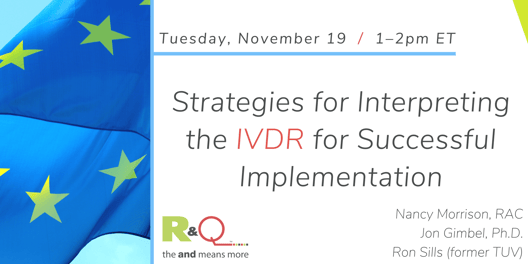From new software and cybersecurity guidance to updates to existing medical software policies, September was a busy month for FDA guidance releases. During our October webinar on FDA Updates for Medical Device Manufacturers, R&Q experts addressed these changes and what impacts our clients should expect.
We focused on what is new, notable, and necessary for medical device manufacturers, particularly items that we anticipate will have the biggest impacts on the medical device industry. Here are the areas that our experts think you should be paying attention to right now: the FDA’s two-phase Breakthrough Devices Program, the Medical Device Development Tools (MDDT) originally piloted in 2013, expected changes during the CDRH Reorganization, harmonization and modernization of the Quality System Regulation (QSR) 13485:2016 for medical devices, and the safety and performance-based 510(k) regulatory clearance pathway.
We were thrilled to receive great questions from our audience regarding the information we covered, many of which focused around ISO 13485:2016 and the harmonization process. Below are our top five Q&As from the webinar, and the full list can be found along with the rest of the on-demand content here.
Q: Will the agency re-classify devices with the integration of new standards (i.e. European classifications differ for some devices)?
A: I would not expect the adoption of 13485:2016 to impact classifications or result in reclassifications. The scope of the standard is for the QMS requirements, and not for market approvals or classification. Those requirements will continue to be regulated separately.
Q: As FDA plans to supplant 21 CFR 820 by ISO 13485:2016, would you expect also an alignment of FDA on the MDSAP to have it adopted as part of the regulatory pathway for the US?
A: MDSAP results affect agency scheduling of routine inspections. I would expect FDA will continue to conduct PMA Pre-market inspections in support of the PMA approval process and MDSAP would not impact this approach. 510K clearance can trigger scheduling of initial inspections of firms, but I anticipate FDA will continue to want to conduct 1st inspection of emerging firms - so generally speaking, no - harmonization won't affect FDA regulatory pathway - although compliance status generally can affect approvals. The MDSAP program is a harmonized approach to QMS certifications but is not designed for regulatory approvals.
Q: How do we know what kinds of clauses we can exclude?
A: I would refer you to the 13485:2016 companion guide available through AAMI (ISO 13485:2016 Medical Devices - a practical guide Advice from ISO/TC 210) Generally speaking, activities that you do not engage in and are not regulatory requirements of the markets you distribute to can be excluded where appropriate. Of course, precedent on FDA interpretations on appropriate exclusions is not yet available - I would expect this issue to be well covered during the rule-making process and expect that ultimately they will be generally consistent with legacy interpretations by Notified Bodies. Exclusions differ from clauses which can be declared and justified as non-applicable. Exclusions are allowed under clause 7.3 design & development with justification. Non-applicability may be declared and justified under clauses 6, 7, and 8.
Q: How will harmonization of the QSR with ISO 13485:2016 affect manufacturers with MDSAP certification given that the program encompasses both 820 and ISO 13485 for U.S. participants? How will the harmonization affect the future adoption of ISO 13485:20XX standards?
A: Harmonization should not impact the FDA's use of successful MDSAP outcomes to replace routine inspections. MDSAP audits cover both the standard and applicable regulatory requirements (like the QSR) - so little impact expected. An interesting question regarding how future versions of the standard get handled and if regulations would have to change..I don't know how this will be managed - perhaps we'll get insight via the proposed rule when published, or via subsequent comments and responses on the proposed rule. Harmonization is likely several years away. Similar to MDSAP, which was originally based on ISO 13485:2013 in the pilot phase, and then updated for the 2016 version, I would expect the harmonization to encompass any updates to the standard.
Q: If a company participates in the MDSAP program, that is audited to 13485. How different would an FDA inspection when they harmonize to the 13485 std if the MDSAP audit is submitted to FDA now?
A: I expect successful MDSAP audits will continue to exempt firms from routine inspections after harmonization. As for differences, we do not have precedent on FDA interpretation of the standard to rely on yet, but I would not expect FDA expectations on best/compliant practices to change significantly.
Click below for answers to more questions like those above and to view the webinar in its entirety.





